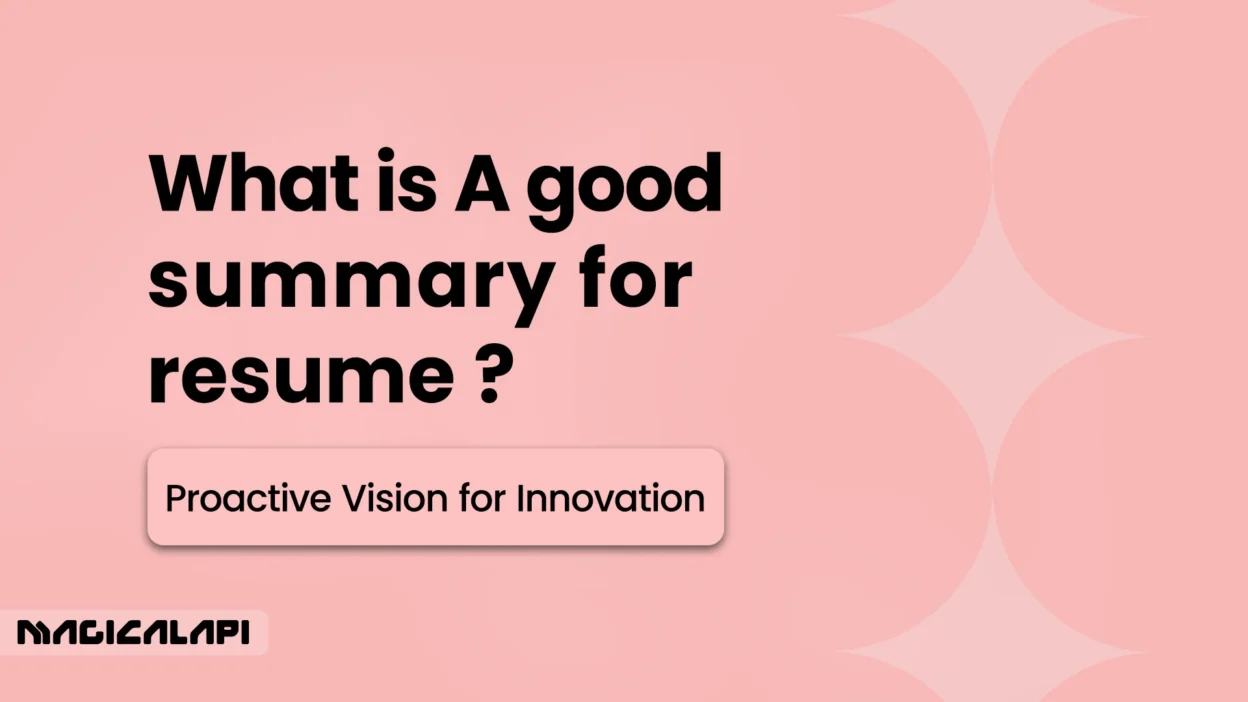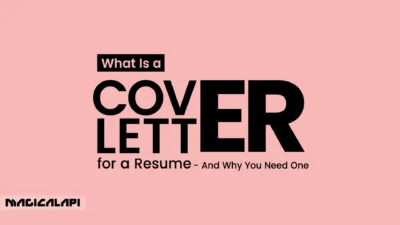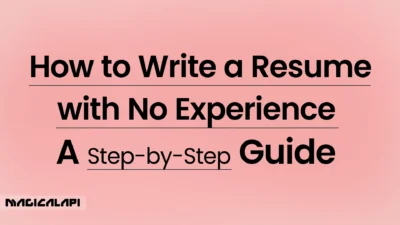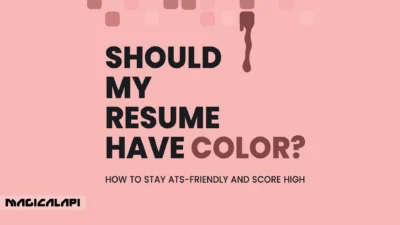What is A Good Summary for Resume? In today’s fast-paced employment market, your resume is your first chance to leave a lasting impression on a hiring manager. One of the best ways to stand out is to create a good summary for resume; a brief, powerful introduction that summarizes your skills, experience, and value.
But how do you accomplish it, and how do you accomplish it? Here in this tutorial, we’re going to guide you through all that you’d like to know regarding resume summaries, from what they are and when to use them to helpful examples and how-to advice for success. You’re a seasoned professional or entering the workforce, you’ll have take-aways that will allow you to create a summary that communicates your vision of innovation to come.
Let’s start and learn how to turn your resume summary into a job search success! and learn more about AI Resume Summary Generators.
Table of Contents
What Is a Resume Summary?
A good summary for resume is a short, personalized statement; typically 3-5 sentences or 50-100 words. This statement is usually found right at the top of your resume. It’s your pitch to hiring managers: a brief summary of you as a pro, what you can offer, and why you’d be an amazing candidate for the position. It’s constructed to lead off with your most relevant skills, experience, and achievements first, providing recruiters a reason to keep reading.
Read More: Top Reasons Your Resume Needs a Summary?
For example, here’s an example of a good summary for resume statement that’s highly likely to catch the attention of the interviewer and respond to the question, what is a good summary for a resume?:
“Extremely talented graphic design professional with extensive training and experience for over 7 years, in designing, building, and delivering brand identity and knowledge on using Adobe Creative Suite. Tested track record for coming up with imaginative campaigns through the increase by 40% in improved client involvement.”.
Unlike a resume objective, which informs the employer of your career aspirations, the summary is more focused on what you can do for the employer. It’s your chance to get an immediate attention-grabber and is therefore a convenient tool for those who like to make an early impression. Optimizing this section can also improve your Resume Score by aligning your strengths with employer expectations right from the start.
Magical Resume Score
Discover everything you need to know about Magical Resume Score , how it evaluates your resume, and the various options available to enhance your job application and improve your chances of success.
When Should You Use a Resume Summary?
You might be wondering, “Is a resume summary right for me?” It really depends on your career aspirations and level of experience, but it’s more versatile than you might think. In most instances, a resume summary is ideal if you have some level of professional experience, especially if you’re a mid-to-senior professional or switching industries. It’s great for showcasing transferable skills or highlighting your skill level in a way that’s relevant to the job that you’re seeking.
For instance, if you’re a marketing manager switching to a sales role, a summary can bridge that gap: “Dynamic Marketing Manager with 8 years of experience in campaign strategy and client relations, adept at driving revenue growth and building partnerships.” This focuses on skills relevant to sales without dwelling on unrelated details.
And what about resume for internship, then? What about the recent graduate? You can use a good summary for resume too! If you have internships, volunteer work, or school projects, a summary can say something about your potential. Here is an example: “Recent Computer Science graduate from XYZ University, with skills in Python and Java, eager to apply coding skills to real-world problems.” It’s not necessarily about years of experience but what you are ready to bring.
The only exception is when you have nothing or little to say or if you want a traditional objective statement. However, most career experts are of the view that a tailored summary typically trumps an objective by highlighting value as opposed to career goals.
Read More: Resume for Internship
10 General Resume Summary Examples
Do you have trouble with writing a resume summary? Let’s take a look at 10 resume summary examples across different professions and experience levels. Each shows how to write a brilliant resume summary that is short, to-the-point, and effective:
- Experienced Marketing Manager
“Results-oriented Marketing Manager with 10+ years in digital marketing, skilled in SEO, social media, and analytics. Increased website traffic by 50% through targeted campaigns and data-driven strategies.” - Recent Graduate (Computer Science)
“Motivated Computer Science graduate with a Bachelor’s from ABC University, proficient in Python, Java, and C++. Completed a capstone project optimizing database performance by 30%.” - Nurse Practitioner
“Compassionate Nurse Practitioner with 6 years in primary care, specializing in patient assessments and chronic disease management. Improved patient satisfaction scores by 25% through personalized care plans.” - Sales Professional
“Top-performing Sales Representative with 5 years of experience, consistently exceeded quotas by 20%. Skilled in negotiation and building long-term client relationships.” - Graphic Designer
“Innovative Graphic Designer with 7 years of experience in branding and print design, expert in Adobe Creative Suite. Created award-winning visuals that enhanced client brand recognition.” - Human Resources Manager
“Strategic HR Manager with 9 years of experience in talent acquisition and employee development. Reduced turnover by 15% through effective training programs and culture initiatives.” - Data Scientist
“Analytical Data Scientist with 4 years of experience, proficient in Python, R, and machine learning. Developed predictive models that improved business forecasting accuracy by 35%.” - Teacher
“Dedicated High School Teacher with 12 years of experience in English literature, skilled in curriculum design and student engagement. Mentored 50+ students to academic success.” - Project Manager
“Proactive Project Manager with 8 years of experience leading cross-functional teams using Agile methodologies. Delivered 15+ projects on time and under budget.” - Customer Service Representative
“Friendly Customer Service Rep with 3 years of experience, known for resolving complex issues quickly. Maintained a 95% customer satisfaction rating in a high-volume call center.”
These examples show how to adapt your summary to your unique background and use them as great starting points for writing your own.
Read More: How to Achieve a High Ats Score Resume?
How to Write a Resume Summary
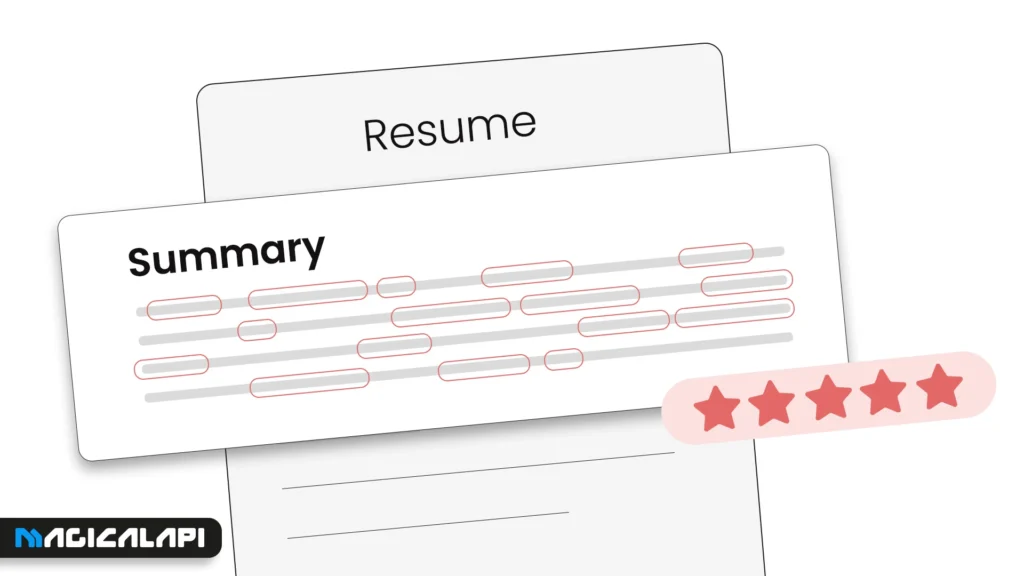
Want to create your own resume summary? Crafting a good summary for a resume should not be daunting. Follow these steps and create one that’s tailored, engaging, and effective:
- Examine the job description.
Start by carefully reading the job advert. Highlight skills, qualifications, and keywords—”project management” or “data analysis,” for example equivalent to your experience. This enables your summary to speak to what the employer is searching for directly.
- List Your Strengths
Jot down your top skills, experiences, and achievements. For example, if you’re a sales rep, note your best sales figures or client wins. Pick the ones most relevant to the job.
- Start with a Strong Opener
Begin with a descriptive phrase like “Results-driven Software Engineer” or “Creative Marketing Specialist.” This sets the tone and grabs attention.
- Highlight Key Skills and Experience
Add 1-2 sentences about your experience and history. Use details like “5 years of web development” or “Adobe Photoshop expert” to add validity.
Add a Quantifiable Achievement
Numbers are what get your summary pumped. Say “increased sales by 25%” or “cut processing time by 15%” to show real impact.
- Keep It Brief
Target 3-5 sentences. Make each word count—cut the fluff like “hardworking” and focus on what sets you apart.
- Use Action Verbs
Words like “led,” “designed,” “improved,” or “delivered” add energy and show you’re a doer, not just a thinker.
- Tailor It Every Time
Customize your summary for each job. A generic version won’t cut it—specificity shows you’ve done your homework.
Here’s an example in action for a Project Manager:
“Organized Project Manager with 6 years of experience leading Agile teams in tech startups. Skilled in Scrum and resource planning, successfully delivered 10+ projects on time, improving team efficiency by 20%.”
Short, sweet, and packed with value!
Read More: best font for resume
Optimizing Your Summary for ATS
Many companies use Applicant Tracking Systems (ATS) to filter resumes before a human ever sees them. To ensure your summary makes it through, you’ll need to optimize it. Here’s how:
- Incorporate Keywords
Scan the job description for terms like “CRM software” or “financial reporting” and weave them naturally into your summary. If the job wants “team leadership,” say “Led a team of 5 engineers.”
- Be Specific
Fuzzy words like “seasoned professional” don’t help ATS or humans. Use instead “3 years customer support” or “AWS certified.”
- Use Simple Formatting
ATS can struggle with stylish fonts or tables. Use plain text, ordinary fonts like Arial, and save your resume as a PDF or Word doc.
- Quantify Results
Numbers like “grew revenue by 30%” are easy to read and show impact. ATS tends to emphasize quantifiable results as some indicators of success.
- Avoid Buzzwords That Are Overused
Get rid of the clichés like “team player” or “detail-oriented.” Choose concrete skills and outcomes instead. Here’s how:
“4+ years certified SQL and Tableau Data Analyst who reduced dashboards to save 25% of reporting time.”
This summary has used keywords, kept the summary specific, and it surely passes the ATS.
Wrapping It Up: Your Path to a Standout Resume Summary
A good professional summary for resume is more than just one or two sentences. It’s your chance to turn loose on your creative juices and show the world that you’re the best possible candidate for the job. After learning about what a resume summary is, when to use it, and through our step-by-step process, you can build a compelling opener that gets read. Tailor it to each role, optimize it for ATS, and back it up with specific achievements, and you’ll be well on your way to landing interviews.
So what are you waiting for? Ask yourself “What is Resume Parsing?” Then pick up that résumé, grab a job ad, and start writing down an overview of your specific abilities. With renewed vigor, you’ll turn that first glance into one that sticks.
FAQs About Good Summary for Resume?
Got questions? Here are answers to some common ones about resume summaries:
How long should a resume summary be?
Keep it to 3-5 sentences or 50-100 words. Long enough to convey value, short enough to stay punchy.
Can I use bullet points?
It’s better to use full sentences for a smooth, narrative flow. Save bullets for your skills or experience sections.
What if I’m new to the workforce?
Focus on transferable skills or education. Try: “Enthusiastic Marketing grad with internship experience in social media, grew follower count by 15%.”
Should I include my name?
No, your name goes at the top of the resume separately. Use the summary to sell your skills.
How often should I update it?
Tailor it for every job application. A little tweaking goes a long way to match each role’s needs.
Can it mention salary expectations?
No. You can save that for the interview. Keep the focus on what you offer.
How do I make it stand out?
Use specific achievements, strong verbs, and job-relevant keywords. Numbers help too!


